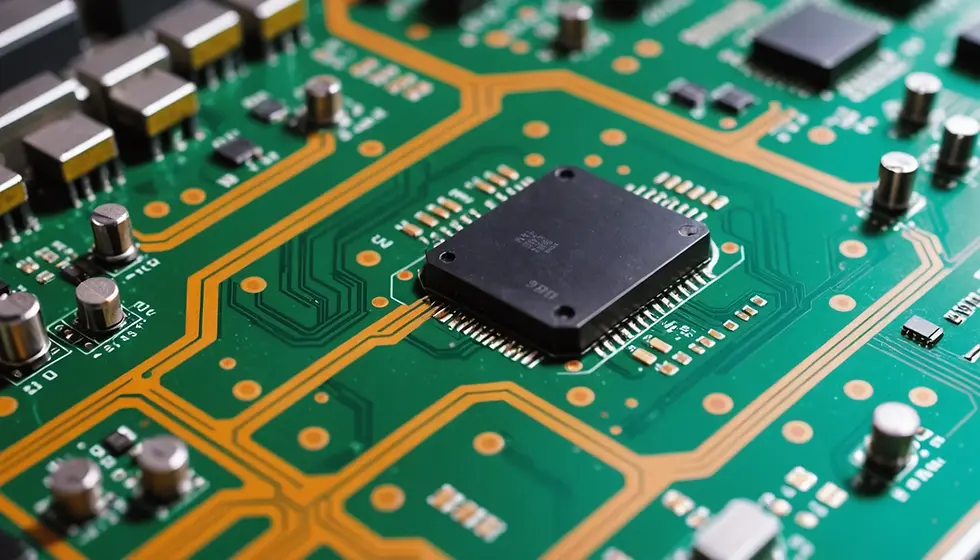Prototyping vs. Manufacturing in Electronics: Bridging the Gap from Concept to Production
- Gulshan Sharma
- Dec 18, 2024
- 4 min read
In the world of electronics, innovation is the driving force that transforms abstract ideas into tangible products. Every revolutionary gadget, circuit, or system begins its journey as a prototype, eventually evolving into a fully manufactured product ready for market. However, the path from prototyping to manufacturing is complex, requiring careful planning and execution. Understanding the distinction between these two phases is crucial for engineers, entrepreneurs, and hobbyists alike to navigate the challenges and intricacies of electronics development.
This article explores the key differences between prototyping and manufacturing in electronics, delves into the nuances of transitioning between these stages, and offers insights to help you succeed in this transformative process.
What is Prototyping in Electronics?

Prototyping in electronics is the process of creating preliminary versions of a product to test its functionality, design, and feasibility. It is an iterative process where ideas are tested, evaluated, and refined.
Types of Prototypes in Electronics
Breadboard Prototypes: Used to validate circuit functionality, allowing for quick and easy adjustments.
3D-Printed Enclosures: Help test the physical form factor and ergonomic design.
PCB Prototypes: Serve as close representations of the final product, testing both functionality and aesthetics.
Common Tools and Techniques
CAD Software: For designing circuits and PCBs.
Development Boards: Arduino, Raspberry Pi, or ESP32 for proof-of-concept projects.
Quick-Turn PCB Services: Providers like JLCPCB or OSH Park facilitate rapid PCB creation.
The primary goal of prototyping is to validate the design concept, identify potential flaws, and ensure that the product meets its intended purpose before committing to large-scale production.
What is Manufacturing?

Manufacturing in electronics refers to the large-scale production of a finalized design for commercial use. It involves setting up processes, tooling, and quality control systems to ensure consistent, reliable, and cost-effective output.
Types of Manufacturing Processes
PCB Assembly (PCBA): Utilizing surface-mount technology (SMT) and through-hole technology for assembling electronic components.
Injection Molding: Used for creating enclosures or casings.
Automated Processes: Pick-and-place machines, wave soldering, and reflow ovens optimize efficiency and precision.
Manufacturing prioritizes scalability, cost-efficiency, and adherence to strict quality standards, with the ultimate goal of producing reliable units that meet market demands.
Key Differences Between Prototyping and Manufacturing
Volume:
Prototyping: Focuses on small-scale production, typically 1 to 100 units, for testing and refinement.
Manufacturing: Involves large-scale production, ranging from thousands to millions of units.
Speed:
Prototyping: Prioritizes quick iterations to test and refine designs.
Manufacturing: Aims for optimized throughput to meet deadlines and demand.
Design Flexibility:
Prototyping: Designs are frequently adjusted based on testing feedback.
Manufacturing: Designs must be finalized and locked down to ensure repeatability and consistency.
Cost Structure:
Prototyping: Higher per-unit cost due to low volume and experimental approaches.
Manufacturing: Lower per-unit cost due to economies of scale but requires significant upfront investment in tooling and setup.
Tooling and Techniques:
Prototyping: Utilizes general-purpose tools like CNC machines and 3D printers for flexibility.
Manufacturing: Relies on specialized equipment tailored to the production process, such as injection molds and automated assembly lines.
Intricacies to Consider During Transition
The transition from prototyping to manufacturing is not merely a matter of scaling up; it requires strategic planning and attention to detail. Here are some critical aspects to address:
1. Design for Manufacturability (DFM):
Simplify designs to align with manufacturing constraints, such as component placement for automated assembly.
Optimize PCB layouts to ensure compatibility with pick-and-place machines.
2. Component Sourcing:
Evaluate the availability of components at scale and identify potential sourcing challenges.
Work with reliable suppliers to secure bulk quantities and manage lead times.
3. Testing and Quality Control:
During prototyping, testing is often manual and focused on functionality.
In manufacturing, automated systems like Automated Optical Inspection (AOI) and In-Circuit Testing (ICT) ensure consistency and reliability.
4. Regulatory Compliance:
Start considering certifications such as CE, FCC, and RoHS during the prototyping stage to avoid redesigns.
Address safety and EMI/EMC regulations early.
5. Supply Chain Management:
Prototyping allows flexibility in sourcing components, often using multiple vendors.
Manufacturing demands a robust supply chain to ensure timely delivery of materials and efficient distribution of finished products.
6. Cost Optimization:
Evaluate the Bill of Materials (BOM) to identify cost-saving opportunities.
Minimize waste during production by refining manufacturing processes.
Challenges in the Prototyping-to-Manufacturing Journey
Transitioning from prototyping to manufacturing is not without challenges. Common obstacles include:
Late Design Changes: Modifications made after finalizing designs can cause delays and additional costs.
Mismatch in Functionality: Differences between prototype performance and manufacturable designs.
Cost Overruns: Unexpected expenses during scaling up production.
Communication Gaps: Misalignment between design engineers and manufacturing teams.
Regional Standards: Overlooking regional manufacturing standards and capabilities can hinder scalability.
Tips for a Seamless Transition
Collaborate Early: Engage manufacturing partners during the design phase to ensure DFM principles are applied.
Pilot Runs: Validate designs with small-scale pilot runs before committing to full production.
Modular Designs: Use modular approaches to allow flexibility and accommodate potential adjustments.
Document Everything: Maintain detailed documentation of design changes, specifications, and testing results.
Leverage Digital Twins: Utilize simulation tools to predict manufacturability and identify potential issues.
Future-Proof Components: Choose components with long-term availability to avoid supply chain disruptions.
Conclusion
Prototyping and manufacturing are two essential stages in electronics development, each serving distinct purposes and requiring unique approaches. While prototyping fosters creativity and experimentation, manufacturing demands precision, efficiency, and consistency. Bridging the gap between these phases involves careful planning, collaboration, and attention to detail.
By integrating manufacturing considerations early in the design process and embracing best practices, innovators can streamline the transition from prototype to product, ensuring success in the competitive electronics industry. Have you navigated the prototyping-to-manufacturing journey? Share your experiences or explore resources to take your electronics projects to the next level.
If you are in need of electronics development, prototyping, or mass manufacturing (BOM procurement, PCB Assembly, Enclosure), please reach out to sales@xelec.in/gulshan@xelec.in.




コメント